
Immigration and Border Security
Numerous voices from both sides of the aisle have called for immigration reform in light of:
- an extraordinary number of immigrants living without legal status in the country (now 10.5 million)
- unresolved issues about how to deal with adults who were illegally brought into the US as children
- a continuous flow of immigrants seeking to cross the border illegally
- a flood of asylum seekers primarily from Central American that have created a major backlog of pending cases
- a huge demand for immigrant workers in various industries.
- National Sample: 2,410 Registered Voters
- Margin of Error: +/- 2.0%
- Fielded: October 19 - November 1, 2019
- Questionnaire with Frequencies
Proposals with bipartisan support discussed below:
- Requiring employers to use the E-Verify system to establish the legal status of current employees and all new applicants
- Creating a new long-term visa for undocumented immigrants, which gives them a path to citizenship, granted they meet certain requirements
- National Sample: 2,407 Registered Voters
- Margin of Error: +/- 2.0%
- Fielded: October 1 - 16, 2018
- Questionnaire with Frequencies
Proposals with bipartisan support discussed below:
- Increasing the number of visas available for guest workers in seasonal non-farm industries from around 66,000 to around 200,000 annually
Proposals that did not have bipartisan support:
- Changing the number of green cards available to:
- Spouses of citizens
- Siblings of citizens
- Parents of citizens
- Adult children of citizens
- Adult children of permanent residents (i.e. green card holders)
- Changing the number of green cards available under the ‘diversity lottery’ program
- Creating a new guest worker visa for season farm workers that has lower wage and benefits requirements for employers
- Changing the legal status of certain undcoumented immigrants brought here illegally as children, by: allowing those currently with DACA protection (~700,000) to get a renewable three-year green card, or providing those currently eligible for DACA (1.2 - 1.8 million) a path to citizenship
- Increasing border security along the southern border, primarily by building a wall
- National Sample: 2,228 Registered Voters
- Margin of Error: +/- 2.1%
- Oversample: 688 respondents from California, Florida and Texas (These data can be found in the questionnaire)
- Fielded: February 21 - March 12, 2018
- Questionnaire with Frequencies
- Full Report
Proposals with bipartisan support discussed below:
- Providing permanent legal status and a path to citizenship to undocumented immigrants who were brought here illegally when they were children, granted they meet certain requirements
Proposals that did not have bipartisan support:
- Changing the number of green cards available to:
- Spouses of citizens
- Siblings of citizens
- Parents of citizens
- Adult children of citizens
- Adult children of permanent residents (i.e. green card holders)
- Changing the number of green cards available under the ‘diversity lottery’ program
- Increasing border security along the southern border, primarily by building a wall
|
DEALING WITH IMMIGRANTS WITHOUT LEGAL STATUS |
|
For many years there has been concerns over what to do about the growing number of undocumented immigrants, many of whom have been here for numerous years, and will likely continue to live and work in the US illegally unless immigration reforms are made. To address this concern, respondents evaluated a proposal for providing certain undocumented immigrants a long-term visa and a path to citizenship. This proposal was based on the Border Security, Economic Opportunity and Immigration Modernization Act of 2013. They were introduced to the topic as follows: We are going to look at a proposal for what the government should do about illegal, or undocumented, immigrants in the US. Currently, there are about 10.5 million immigrants in the US who do not have legal status. While the number increased in the 1990s, it stabilized around 2005 and more recently has come down a bit. A bit less than half are people who entered the US legally with a work or travel visa and then overstayed, while a bit more than half are people who crossed the US border illegally. About two thirds of such adult immigrants have been here more than 10 years. Some people favor trying to deport most or all of these immigrants, but others say that they should be offered a way to live here legally. The specifics of the proposal were then described: Immigrants without legal status could apply for a new type of visa, if:
This new type of visa would:
They would eventually be allowed to apply for citizenship, but they would have to go to the back of the line, like anyone who applies for citizenship. Arguments for and against the proposal were then evaluated. The pro argument was found convincing by a much larger margin than the con argument, with significant partisan differences. While both arguments were found convincing by majorities (pro 74%, con 57%), the pro argument was found convincing by majorities of both Democrats (90%) and Republicans (58%), whereas the con argument was found convincing primarily by Republicans (81%), with just one third of Democrats agreeing. Asked to rate how acceptable the policy would be on a 0-10 scale, it was found at least tolerable (5-10) by 84%, including 73% of Republicans and 93% of Democrats.
When the question even just mentioned that there would be requirements without specifying them, this has elicited robust support, though a bit lower.
When the question did not specify any requirements Republican support has dropped sharply to a minority, and when offered the option “neither favor or oppose” large numbers chose it.
Given a menu of options for what government policy should be toward unauthorized immigrants in the US, majorities have supported some type of pathway to citizenship provided that requirements are specified, however in some cases Republicans were divided: Presented four options, a bipartisan majority of 64% (Republicans 51%, Democrats 77%) chose options that included a path to citizenship
The remainder chose either requiring them “to leave their jobs and leave the U.S.” (22%, Republicans 36%, Democrats 10%) or allowing them “to stay in their jobs with work permits, but not apply for U.S. citizenship” (11%). (2017, Chicago Council of Global Affairs) Presented four options In 2016, a bipartisan majority of 67% (Republicans 54%, Democrats 79%) chose the option to:
The remainder chose either making them all “felons and send them back to their home country” (17%, Republicans 26%, Democrats 9%) or allowing them stay as a “guest worker… but only for a limited amount of time” (10 - 14%). (2016 American National Election Survey Pilot) When given a menu of options that did not include one with well-specified requirements, Republican support for a path to citizenship has dropped sharply. Presented four options in 2018 a bipartisan majority of 58% (Republicans 33%, Democrats 75%) selected:
The remainder chose either to make them all “felons and send them back to their home country” (27%, Republicans 50%, Democrats 10%) or allow them to stay as a “guest worker so they can work” (15-17%). (2018 American National Election Survey) Status of Legislation The proposal is in the US Citizenship Act, by Rep. Linda Sanchez (D) (H.R. 1177) and Sen. Robert Menendez (D) (S. 348) in the 117th Congress. The bill has not yet made it out of committee. |
|
Since the Obama administration implemented the Deferred Action for Childhood Arrivals (DACA) -- providing temporary protection from deportation to undocumented immigrants brought here illegally as children -- there have been concerns over what to do about this population, which continues to live in a legal limbo. Respondents were presented a proposal to address this concern, which would grant DACA-eligible immigrants a more permanent legal status and a path to citizenship, if they meet certain requirements. This proposal was based on the Dream Act (H.R. 3440, S. 1615). Before being introduced to the above proposal, respondents were informed about the details of the DACA program: As you may know there is a major discussion these days about what should happen to people who were brought into the US as minors and never got legal status but have lived here many years. In 2012, the Deferred Action for Childhood Arrivals program, popularly known as DACA, was established to allow these people (commonly referred to as ‘Dreamers’) to apply for a special status so that they:
provided that they:
This status expires after two years and can be renewed provided that the person has not committed a significant crime. Approximately 887,000 young people applied for this status, though it was estimated that about 900,000 more were eligible but did not apply (presumably because they were afraid that revealing their illegal presence to the government might someday become a problem for them). In 2017, this DACA program was ended so that no new applications would be accepted. Those currently having this protected status will begin to lose it as their two‐year term runs out. They would then become subject to being deported as an illegal alien‐‐for some as soon as this March. They were then presented the proposal for granting certain DACA-eligible immigrants a more permanent legal status and path to citizenship: Currently, there is a proposal for creating a legal status for 1.8 million people who were eligible under the DACA program. They would also be eligible to apply for citizenship in 10‐12 years provided that they:
They were then asked to evaluate arguments for and against this proposal. Both of the arguments in favor of the proposal were found convincing by very large bipartisan majorities. The arguments against did much less well, but still large majorities of Republicans found them convincing.
With fewer details of who is eligible for legal status and/or citizenship, overall support has still been high, but lower among Republicans, even dropping below half in one case:
However, in at least one case, when the alternative to allowing them to remain is specified as requiring them to leave the US, Republican support once again is a large majority.
When given a hypothetical example of an undocumented immigrant who was brought to the US as a child but does not qualify for DACA, a bipartisan majority has nonetheless opposed deporting them:
In one survey that only referred to ‘minors’ who entered the US illegally, support for allowing them to remain has been divided along partisan lines:
Status of Legislation This bill was reintroduced by the same sponsors (H.R. 2820, S. 874) in the 116th Congress, and has not yet made it out of committee. In the 117th Congress, this proposal is in the larger immigraiton reform bill, the American Dream and Promise Act (H.R. 6), sponsored by Rep. Lucille Roybal-Allard (D). This bill passed the House, with 230 Democrats and 7 Republicans voting in favor, and 187 Republicans voting against. The bill has yet to be taken up by the Senate. It is also in the Dream Act of 2021 (S. 264) by Sen. Dick Durbin (D), which has not yet made it out of committee. |
|
Respondents were presented briefing material on illegal immigration across the souther border as part of an in-person deliberation conducted by Stanford University’s Center for Deliberative Democracy in September 2019. Here are some excerpts: One potential strategy is to prioritize only certain categories of undocumented immigrants — such as those convicted of crimes — for deportation... On the one hand, many policy experts and ordinary citizens are concerned about the rule of law and effective control of our borders. Millions of undocumented immigrants are here in violation of the law, and strict application of the law would require that they leave. From one perspective, justice or procedural fairness requires that they return to their home countries and, in effect, get to the back of the line. Ultimately, truly enforcing the security of our borders means deporting people who come into the country illegally. On the other hand, undocumented immigrants may not be able to safely return to their countries of origin. For some, the US is the only home that they know. Do they then have the right to pursue the American dream of “life, liberty, and the pursuit of happiness” if they are law-abiding, productive and contribute to our society? Or should these rights apply only to citizens and legal residents? They were presented with a proposal and arguments for and against it, as follows: Proposal: First-time violators of immigration laws should only be expelled, not subject to criminal punishment. Argument in Favor: A policy of criminality that punishes all unauthorized entrants would deter refugees fleeing persecution from seeking asylum. A policy of criminal punishment would separate families, harming the vulnerable children of undocumented immigrants, who would be left in the care of strangers while their parents are in prison. Argument Against: Asylum seekers can avoid prosecution and criminal punishment if they make their claims at official border crossings. A policy of criminally punishing all violators of immigration laws is an effective way to deter illegal immigration. Foreigners can avoid criminal punishment by complying with US immigration laws. They were not asked to rate the arguments. After receiving the briefing material, respondents deliberated on the proposal in-person. Finally, they were asked for their final recommendation. On a 0-10 scale, 69% favored the proposal (6-10), including 68% of Republicans and 75% of Democrats. Status of Legislation |
|
DETERRING ILLEGAL IMMIGRATION |
|
There has long been a concern about undocumented immigrants being hired illegally by US employers. Since 2010, legislation has been introduced in every Congress that would require all employers to use the electronic legal employment verification system (E-Verify), or some version of it, with penalties for employers that fail to use it. Before respondents evaluated this proposal, they were introduced to the topic as follows: We will now explore another major proposal. It seeks to discourage illegal immigration by requiring employers to use a government system to verify that the people they hire have the legal right to work in the US (by being a citizen, having a green card, or having a work visa). They were then presented the proposal: The employer would be required to go to an existing government website, called E-Verify, where the employer can enter the name and Social Security number of the people they want to hire. The website then verifies whether or not each employee has a legal right to work. All new job applicants would need to be checked out as well. Employers who do not verify their employees and are found to be employing undocumented immigrants will be fined. Employers who repeatedly fail to use the verification system and hire undocumented immigrants may be sentenced to up to 18 months in prison and their business license may be revoked. Several arguments for and against the proposal were evaluated. The pro arguments were consistently found convincing by a larger percentage than the con arguments. The con arguments were also found convincing by majorities with the exception of the one that said that it was not employers’ responsibility to help enforce immigration law -- only 40% found this convincing, with similar numbers among partisans. Republicans were more likely to find the pro arguments convincing than Democrats. In the end, the proposal to mandate the use of an electronic employment verification system in order to discourage the hiring of undocumented was found convincing by a large bipartisan majority of 73% (Republicans 80%, Democrats 68%). Before receiving any briefing materials or engaging in the deliberation process respondents were given the same poll question as those asked afterwards. Support increased from the pre-deliberation poll to the post-deliberation, overall (71% to 74%) and among Democrats (59% to 69%). Republicans were unchanged. Related Standard Polls
Status of Legislation This proposal was also introduced in several bills in the 116th Congress, all of which were then reintroduced in the 117th Congress by the same sponsors:
None of these bills have yet to make it out of committee. |
|
INCREASING THE NUMBER OF WORK VISAS |
|
While there has long been a concern about undocumented immigrants being hired illegally by US employers, there is also concern about meeting the needs for temporary workers in seasonal industries. Respondents evaluated a proposal to bring undocumented immigrants working in the US into the legal workforce by increasing the number of available visas for guest workers in seasonal, non-farm industries. This was based on a provision in the Small and Season Businesses Relief Act (H.R. 4207) and the Small Businesses Assistance Act (H.R. 1627). Respondents were introduced to the topic as follows: We would now like to consider a proposal for reducing the number of undocumented workers in these industries by bringing more of them into the legal immigration system. Currently, to fill these temporary positions employers can request visas so that they can hire foreign workers on a temporary basis. However, they must first go through a process with the Department of Labor to try to hire American workers. Once it is determined that the workers are needed, the company can take applications from foreign workers. The workers are granted visas to come into the US and work for nine months. Employers must pay the same prevailing rate as Americans are paid for the same work (determined by the Department of Labor (DoL) or an independent source approved by the DoL). Such visas are renewable for up to three years. After that the worker must return home for at least three months before reapplying. These workers are not allowed to collect any public benefits, but they do pay federal, state and local taxes. These visas are called H-2B visas and up to 66,000 are issued annually. This number has varied depending on what Congress decides and has been both substantially higher and lower than the current number. Demand for these workers has gone up and down over the years. Right now, demand is high because of low unemployment The proposal was then presented: Currently, there is a proposal in Congress to enable the Departments of Labor and Homeland Security to provide substantially more of these H-2B visas. In the current labor market this would likely increase the number of workers with such visas to about 200,000 and in future years could go higher. If the labor market were to change and more Americans were to want those jobs, the number would go down. Arguments for and against the proposal were then evaluated. The argument in favor was found convincing by a substantially larger percentage than the argument against (80% to 55%). There were few partisan differences, with Republicans and Democrats finding the arguments convincing at similar rates. In the end, a bipartisan majority of 69% favored this proposal, which included 73% of Republicans and 67% of Democrats. Asked to rate how acceptable the proposal would be using a 0-10 scale, 67% found it at least tolerable (5-10), including 72% of Republicans and 65% of Democrats. Curiously, the at-least-tolerable numbers were slightly lower than for those who favored the proposal. Status of Legislation There is a similar proposal in the Prioritizing Help to Businesses Act (S. 135), sponsored by Sen. John Thune (R) in the 116th Congress, which would allow an increase in available H2B visas, but only in states with especially low unemployment rates. This bill was reintroduced in the 117th Congress by the same sponsor (S. 495). It has not yet made it out of committee. The proposal is also in H–2B Returning Worker Exception Act of 2021 by Rep. Henry Cuellar (D) in the 117th Congress. It has not yet made it out of committee. |
|
To address the concern that there is a shortage of both low-skilled and skilled workers in certain US industries, some have proposed increasing the amount of visas available for immigrant workers to come to the US. Respondents were presented with the following briefing material as part of an in-person deliberation conducted by Stanford University’s Center for Deliberative Democracy in September 2019. They were informed about the ...immigrants admitted for employment purposes. This includes both high-skilled and low-skilled workers. For high-skilled labor, the most common types of merit-, investment-, or skill-based immigration involve L-1, H-1B, O, and EB-5 visas. L-1 and H-1B visas fall into the nonimmigrant visa category, which means that workers use these who may only plan to live in this country during the course of a single multi-year job. Technically, these types of visas are not for immigrants but for temporary workers, sometimes referred to as “guest workers.” For example, the H-1B visa is initially a 3-year visa, renewable for a second 3-year term, for a total of 6 years and it may be extended in 1-year intervals if the employer sponsors a green card application for the worker. For low skilled labor, EB3 visas are one option. EB3 visas apply to jobs that require less than two years of training or experience. A temporary visa called H2A is also available for agricultural workers. These visas are generally for seasonal workers. They were first presented with a proposal and arguments for and against increasing the number of low skilled workers, as follows: Proposal: Increase the number of visas for low-skilled workers so enough workers can be hired for American industries that need them, like agriculture and service. Argument in Favor: US companies would be better able to respond flexibly to labor shortages in the low-skilled sector if they can more easily hire migrant workers. This also keeps prices low for food and other agricultural products. The pressure to work and migrate illegally will be reduced in proportion with the size and flexibility of temporary work visas. For many low-skilled workers from developing countries, the opportunity to work in the US represents their only realistic chance to escape severe poverty. Argument Against: Increasing the pool of low-skilled workers may reduce wages and increase the risk of unemployment for those US citizens who compete for jobs in low-skilled sectors. The US is not responsible for promoting the economic well-being of foreigners. Respondents then deliberated on the proposal in-person. Finally, they were asked for their final recommendation. On a 0-10 scale, 77% favored the proposal (6-10), including 66% of Republicans and 87% of Democrats. |
|
As part of the larger CDD deliberation discussed immediately above, respondents were also asked to evaluate the option of increasing the number of skilled workers as well as the low-skilled workers discussed above. They were presented with a proposal and arguments for and against it, as follows: Proposal: Increase the number of visas for skilled workers to move to the US. Argument in Favor: Many US high-tech companies have a greater demand for skilled workers than the US citizen talent pool can fulfill. Greater access to skilled immigrants will help such companies get the workers they need. Attracting more highly skilled immigrants to work in the United States would help to boost innovation and productivity in the economy. Argument Against: The government should pursue policies to increase the home-grown pool of skilled workers, instead of relying on migrant labor. For example, the government might act to make American higher education more affordable and accessible. Poaching skilled professionals from developing countries causes those countries to suffer “brain drain.” For example, recruiting more doctors from developing countries could undermine health care in those countries. The US has a responsibility not to worsen brain drain in developing countries. After receiving the briefing material, respondents deliberated on the proposal in-person. Finally, they were asked for their final recommendation. On a 0-10 scale, 80% favored (6-10) the proposal, including 72% of Republicans and 86% of Democrats. |
|
Respondents were introduced to the proposal for increasing the number of green cards issued under the employment‐based program as follows: This proposal calls for increasing the number of people that are provided green cards as part of a program that requires that applicants have skills which employers in the US labor market seek. This includes immigrants who are skilled workers, professionals, executives, and people with exceptional abilities in various fields. In most cases, applicants already have job offers in the US and the employers act as the sponsors. The Department of Labor must then certify that:
Currently, about 140,000 green cards are issued each year under this program. This number includes immediate family members as well as the applicant. About 10,000 of these green cards go to people who have the means to invest at least $500,000 in a new business that will create at least 10 jobs. They then evaluated arguments for and against such an increase. Both arguments were found convincing by around two thirds of respondents, with the pro argument receiving more support than the con (70% to 62%). Responses were less partisan than usual with majorities of both Democrats and Republicans finding both arguments convincing. However, the argument in favor was found more convincing by Democrats by about 20 points, and the argument against by Republicans by about 20 points. Status of Legislation |
|
DEALING WITH REFUGEES |
|
There has been a concern about the large backlog of asylum cases in the US, which has resulted in asylum-seekers waiting in the US, sometimes in detention, for years before a decision is made about their asylum status. Respondents were presented with the following briefing material as part of an in-person deliberation conducted by Stanford University’s Center for Deliberative Democracy in September 2019: The upsurge in asylum seekers arriving from Central America to the southern US border is a crisis that has generated a huge backlog in processing asylum claims. Immigrants are eligible for asylum under law if they can show they have, in their home country, been a victim of or have a well-founded fear of persecution based on their race, religion, nationality, political opinion or membership in a particular group. A federal courts recently affirmed that, under these guidelines, immigrants can seek asylum in the US to escape situations involving domestic violence and gang violence. Opinions differ on whether the policy applies to victims of gang violence in Central America, and the Trump Administration is seeking to narrow the grounds for asylum. One solution to the surge of asylum claims might be to hire more immigration judges and other agency personnel. For example, the Trump Administration’s 2019 budget proposal included a request for $71.1 million to support 600 new positions. Also, in July 2019, the Senate passed a bill providing $45 million to hire 30 new immigration judge “teams.” It’s very difficult to effectively police all border crossings — the US has an almost 2,000-mile land border with Mexico, and some of the most significant post-9/11 security threats have been detected on the US-Canadian border. In 2013, the Senate passed a bill increasing border security through physical barriers and surveillance was passed with bipartisan support. Moreover, border enforcement cannot stop immigrants from violating the terms of their visa, for example by overstaying, which is estimated to account for more than half of all undocumented immigrants. Many conflicting values exist in these policy decisions. On the one hand, many policy experts and ordinary citizens are concerned about the rule of law and effective control of our borders. Millions of undocumented immigrants are here in violation of the law, and strict application of the law would require that they leave. From one perspective, justice or procedural fairness requires that they return to their home countries and, in effect, get to the back of the line. Ultimately, truly enforcing the security of our borders means deporting people who come into the country illegally. On the other hand, undocumented immigrants may not be able to safely return to their countries of origin. For some, the US is the only home that they know. Do they then have the right to pursue the American dream of “life, liberty, and the pursuit of happiness” if they are law-abiding, productive and contribute to our society? Or should these rights apply only to citizens and legal residents? What about the DACA recipients who were brought here as children and know no other country? What rights do they have? Would the liberties we take for granted be sacrificed if large-scale police action were required to force millions to leave, or make them live under threat? They were presented with a proposal and arguments for and against it, as follows: Proposal: Increase personnel in order to process asylum seekers’ claims faster. Argument in Favor: The existing system is overwhelmed by the record number of Central American asylum seekers arriving at America’s southern border. Given their enormous workloads, immigration officers and judges make lots of mistakes. They sometimes deport refugees who are in fact subject to persecution in their home countries. At other times, they give asylum to migrants who are not entitled to it. Processing times for asylum claims range from two to five years. As they await a final decision, refugees remain in limbo, unable to build a stable life for themselves either in the US or their homeland. Argument Against: To make an impact, the government will need to hire at least 600 more personnel at an estimated cost of $71.1 million. This money could be better spent deterring refugees who recognize that they don’t have a credible asylum claim and are really coming to the United States to find jobs. US government funds should be used to assist Central American countries whose desperate economic conditions are causing mass migrations to the US in search of employment. After the deliberation, respondents were asked whether they favor or oppose the proposal. On a 0-10 scale, with 5 being “in the middle”, 93% favored the proposal (6-10), including 90% of Republicans and 96% of Democrats. Before receiving any briefing materials or engaging in the deliberation process respondents were given the same poll question as those asked afterwards. Support increased from the pre-deliberation poll to the post-deliberation poll, overall (75% to 93%), and among Republicans (64% to 90%) and Democrats (83% to 96%). |
|
There has been a concern about the poverty and violence in Central America, and how it is contributing to the growing refugee population in that area, and the growing number of asylum-seekers coming to the US. Respondents were presented with the following briefing material as part of an in-person deliberation conducted by Stanford University’s Center for Deliberative Democracy in September 2019: Reasons for the refugee asylum crisis include gang violence and corruption in their native countries. However, data shows that average incomes have grown robustly in all countries for the past decade, and homicides have been on the decline in Honduras and elsewhere since 2012. One theory is that foreign aid from the US to Central American countries may help reduce poverty and violence. Another factor perhaps causing the asylum crisis is the incentive posed by US policy that mandates granting of provisional residence to any asylum applicant who is traveling with children until a hearing to determine their status, which can take years. They were presented with a proposal and arguments for and against it, as follows: Proposal: Provide aid to reduce poverty and violence in Central America. Argument in Favor: Promoting economic growth, increasing job opportunities, and strengthening police and law enforcement in Central America will greatly reduce migration at the US-Mexican border, because many migrants are fleeing violence and lawlessness. Targeted initiatives, supported by US funds, can help Central American governments reduce violence in their countries. For example, drug cartels have destroyed effective law enforcement in these countries. The US can aid in the reconstruction of effective and honest police forces and judiciaries. The US can also fund an ambitious job training program to help young people and steer them away from drug gangs. Argument Against: It isn’t clear that US aid could actually reduce migration from Central America. It would be more effective to deter them from coming to the US by threatening them with long-term detention at the border while their asylum claims are processed. Why should we Central American governments with aid when they aren’t doing their jobs to restrain immigration? The way to stop this illegal immigration is for the US to demand that Mexico stop refugees who have crossed from Central America into Mexican territory from moving northwards into US territory. Mexico should instead arrange for refugees to claim asylum in Mexico. After the deliberation, respondents were asked whether they favor or oppose the proposal to provide aid to reduce poverty and violence in Central America. On a 0-10 scale, 57% favored the proposal (6-10), including 70% of Democrats, but just 38% of Republicans. However, the total percent that did not oppose the proposal was a bipartisan majority of 77%, including 89% of Democrats and 65% of Republicans. |





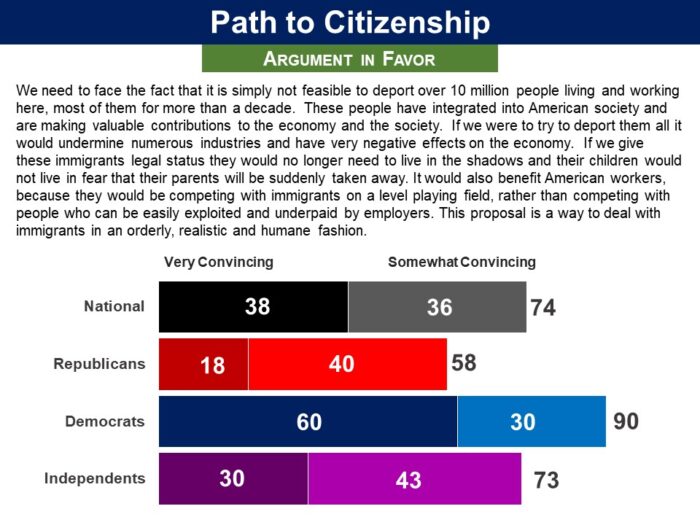
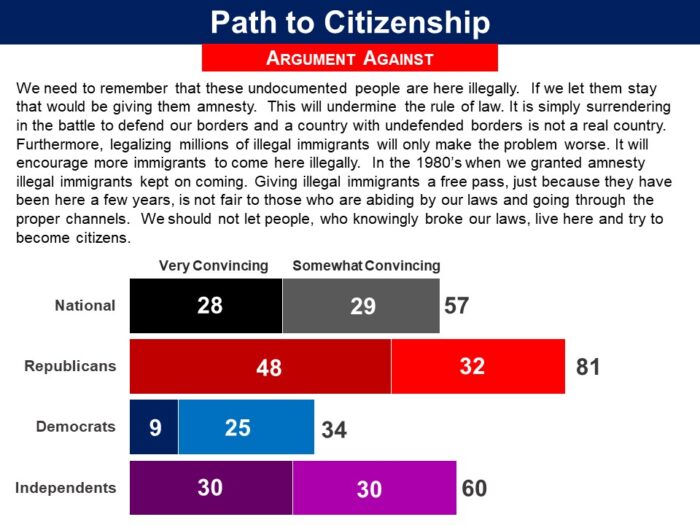 Asked to make their final recommendation, a bipartisan 74% favored the proposal, including 55% Republicans as well as 92% of Democrats.
Asked to make their final recommendation, a bipartisan 74% favored the proposal, including 55% Republicans as well as 92% of Democrats. 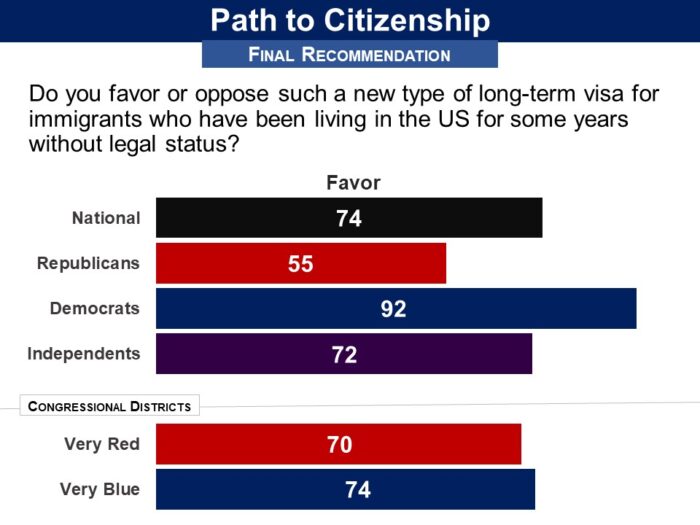
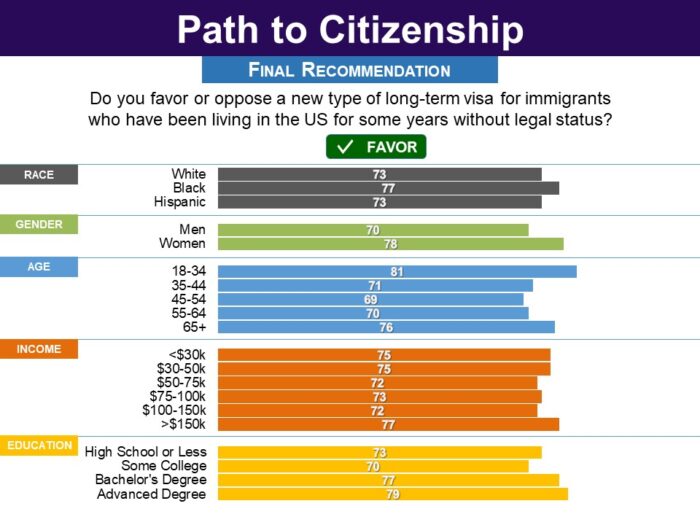 Related Standard Polls
Related Standard Polls

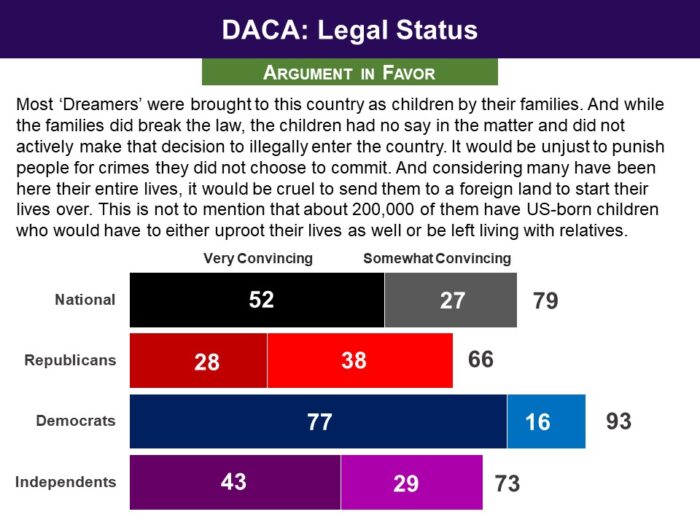
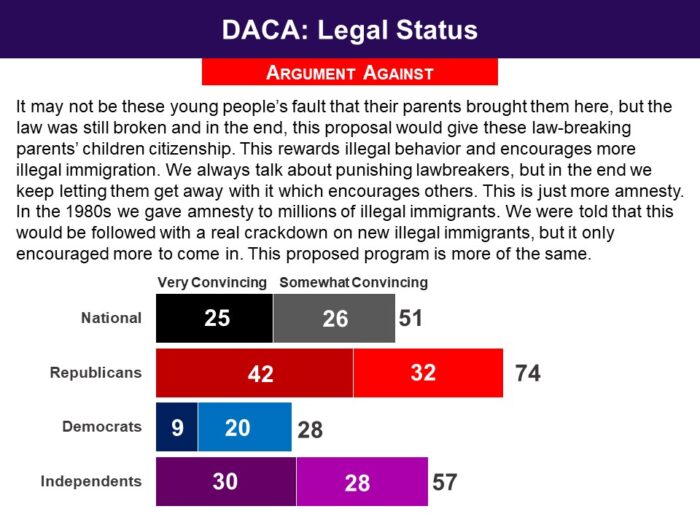
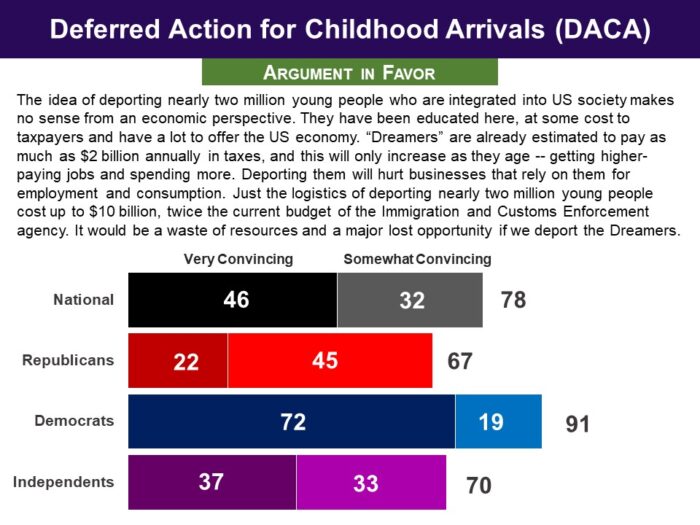
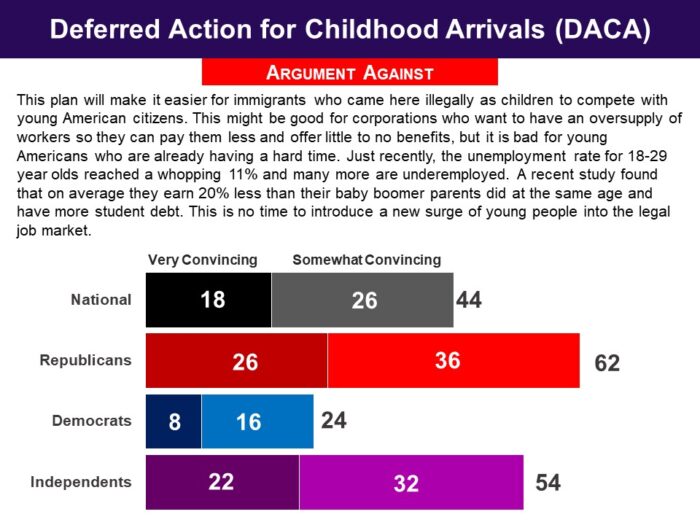 Asked for their final recommendation, an overwhelming 80%, including 69% of Republicans as well as 92% of Democrats, approved of the plan to give the 1.8 million ‘Dreamers’ legal status and a path to citizenship. Support was overwhelming in very red and very blue districts as well as Texas, Florida, and California.
Asked for their final recommendation, an overwhelming 80%, including 69% of Republicans as well as 92% of Democrats, approved of the plan to give the 1.8 million ‘Dreamers’ legal status and a path to citizenship. Support was overwhelming in very red and very blue districts as well as Texas, Florida, and California.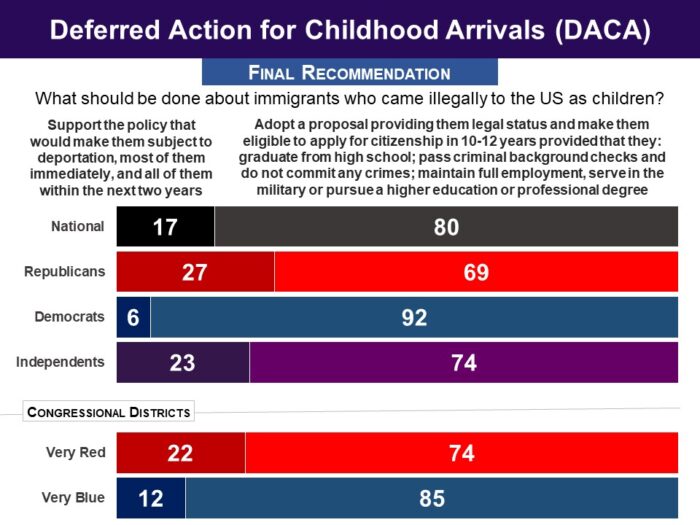
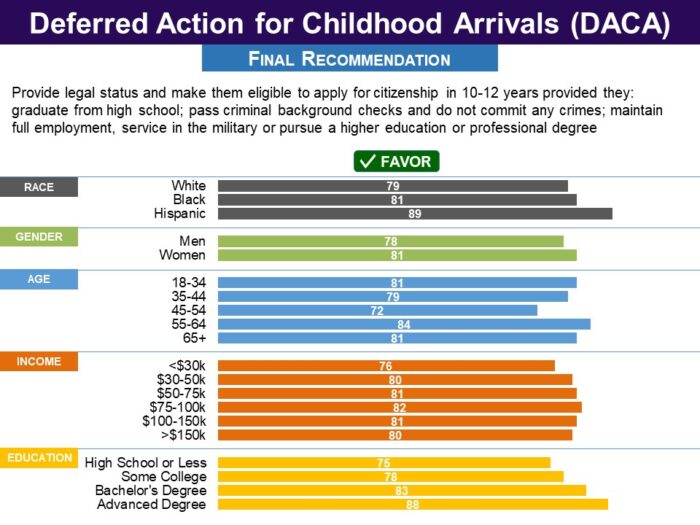 Related Standard Polls
Related Standard Polls

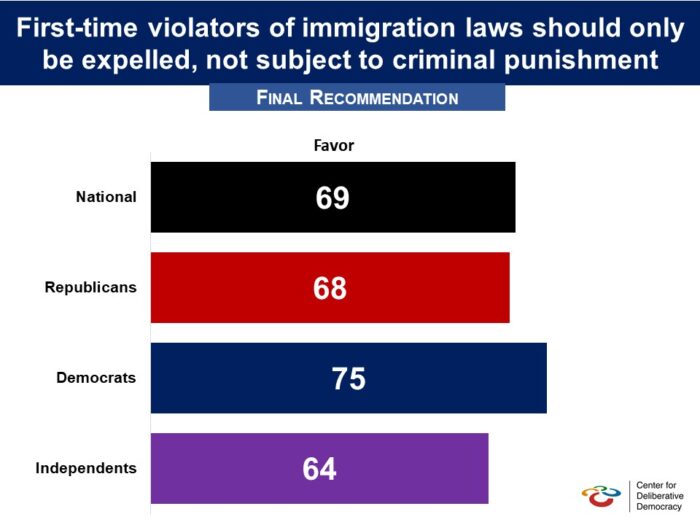 Pre-Deliberation Poll
Pre-Deliberation Poll

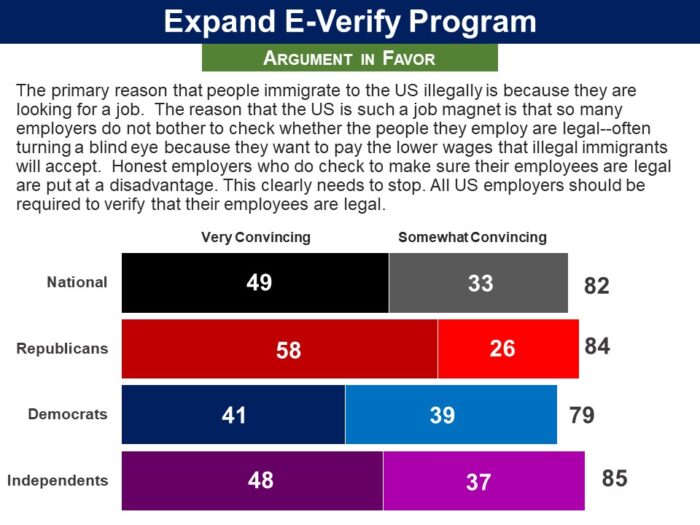
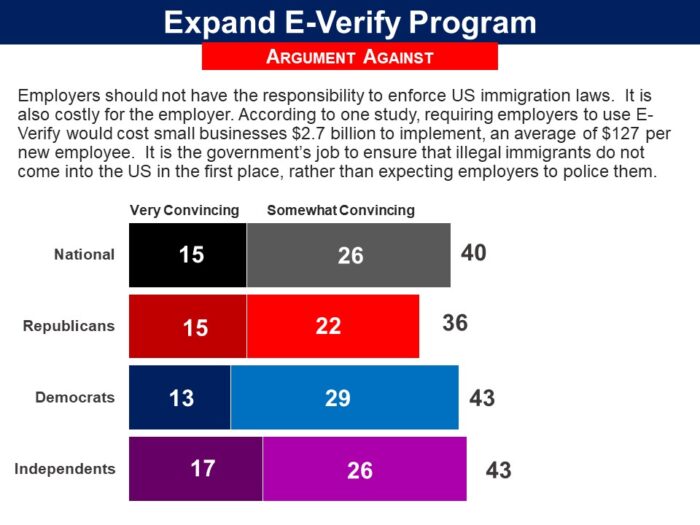
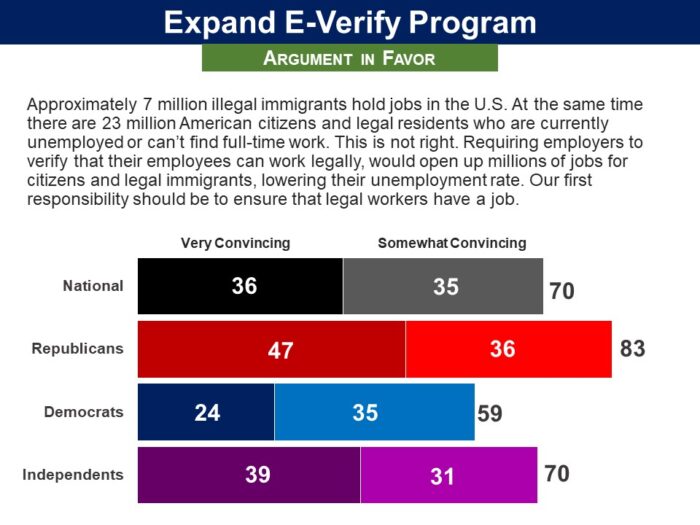
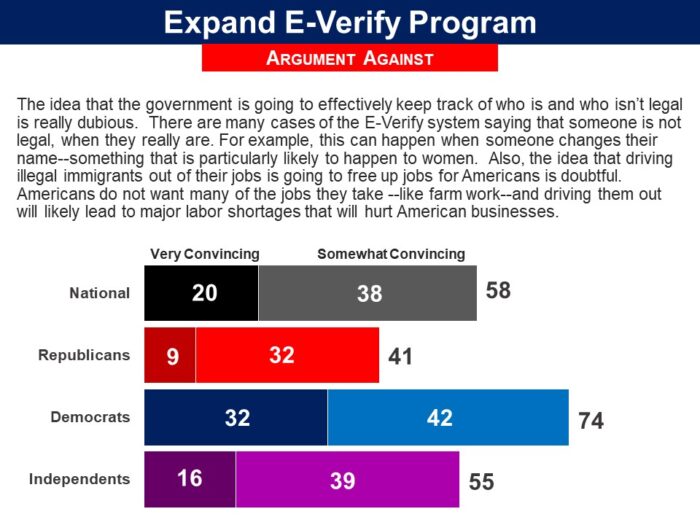
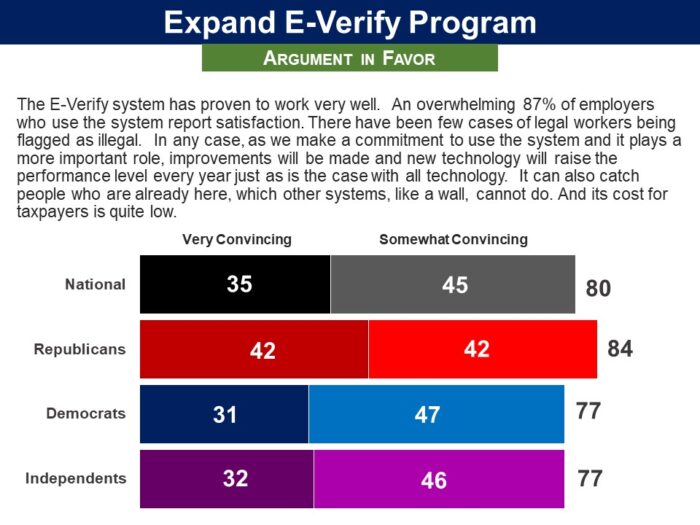
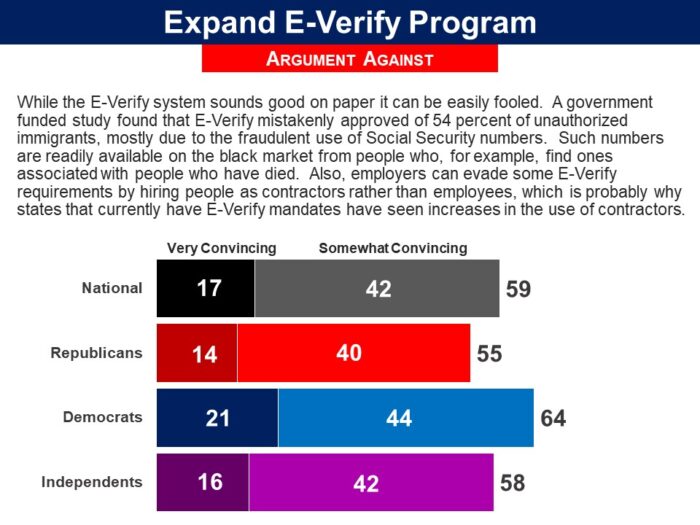
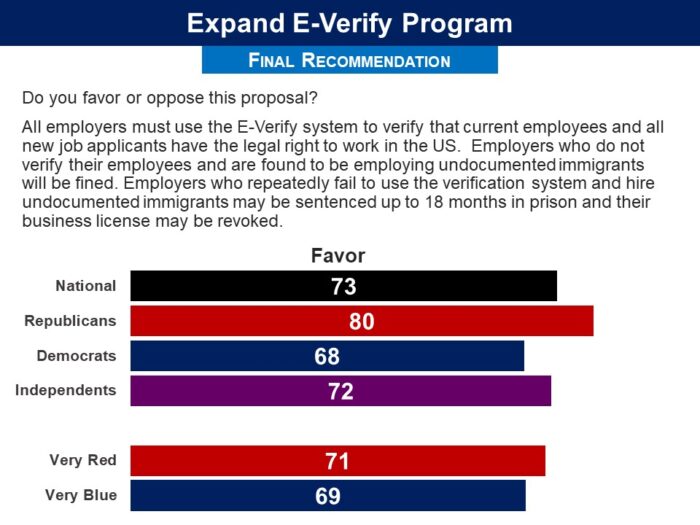 They were also asked how acceptable the proposal would be to them on a 0-10 scale. It was found tolerable (5-10) by 83%, including 88% of Republicans and 79% of Democrats.
They were also asked how acceptable the proposal would be to them on a 0-10 scale. It was found tolerable (5-10) by 83%, including 88% of Republicans and 79% of Democrats.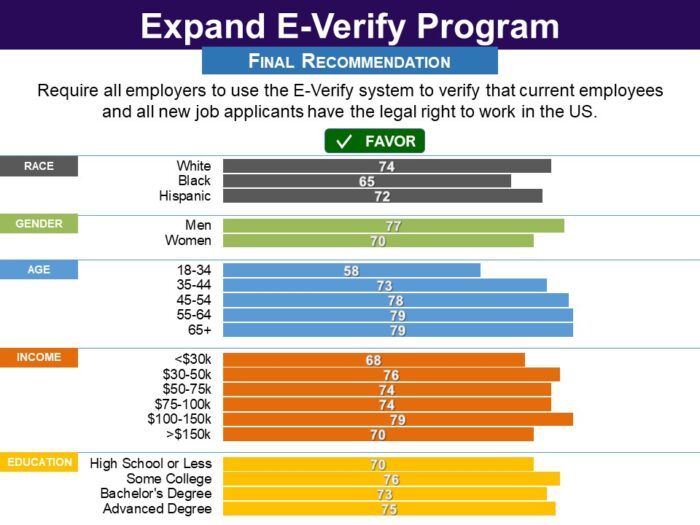 Results of CDD Survey
Results of CDD Survey
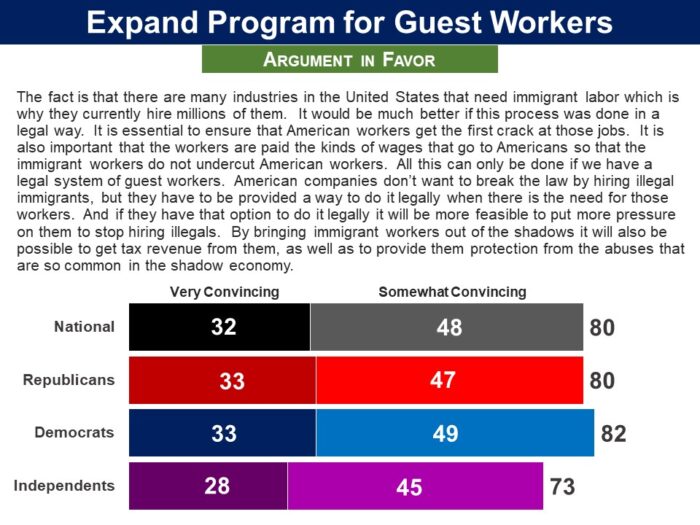
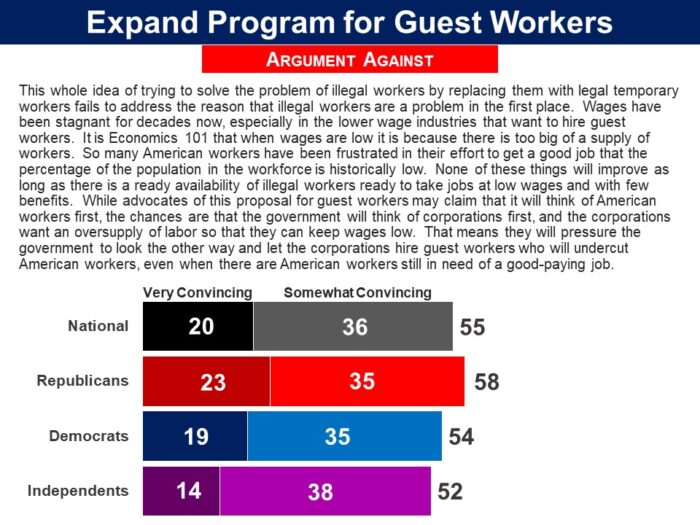
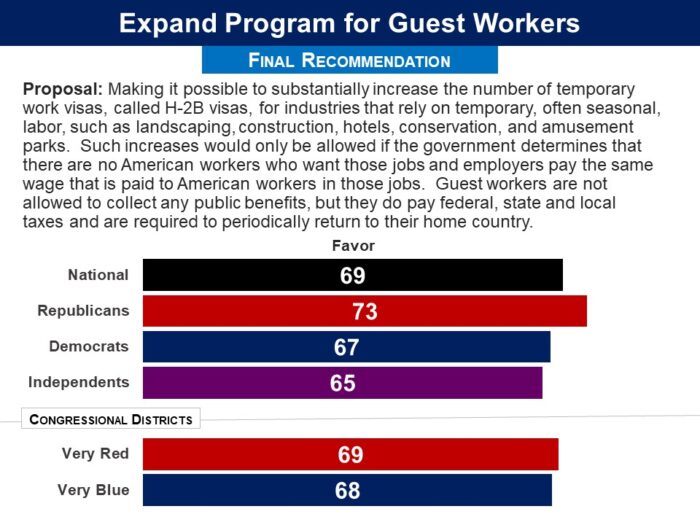
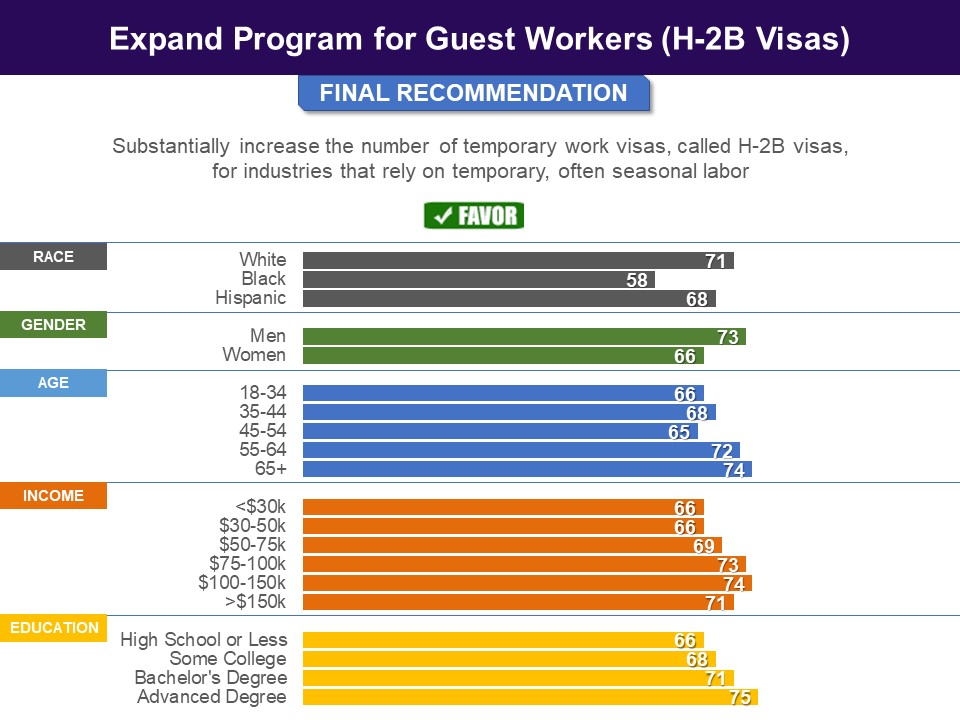



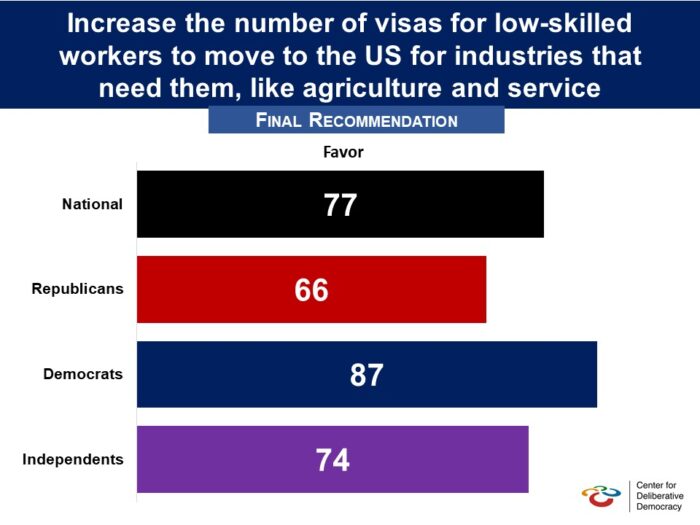 Pre-Deliberation Poll
Pre-Deliberation Poll

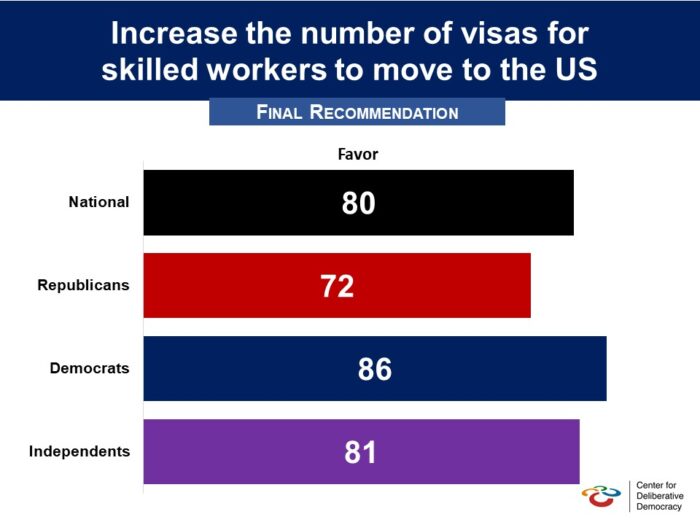 Pre-Deliberation Poll
Pre-Deliberation Poll


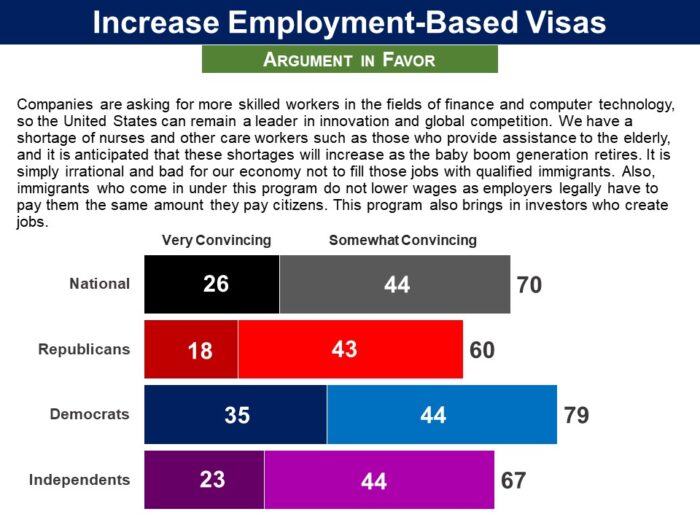
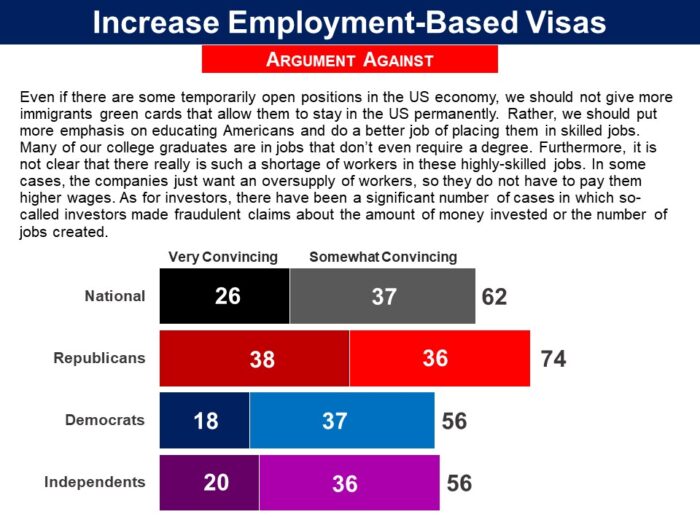 Asked for the final recommendation on increasing the number of immigrants under this program, a modest majority were in favor (54%). There were partisan differences, with 63% of Democrats favoring the idea, compared to 46% of Republicans.
Asked for the final recommendation on increasing the number of immigrants under this program, a modest majority were in favor (54%). There were partisan differences, with 63% of Democrats favoring the idea, compared to 46% of Republicans. 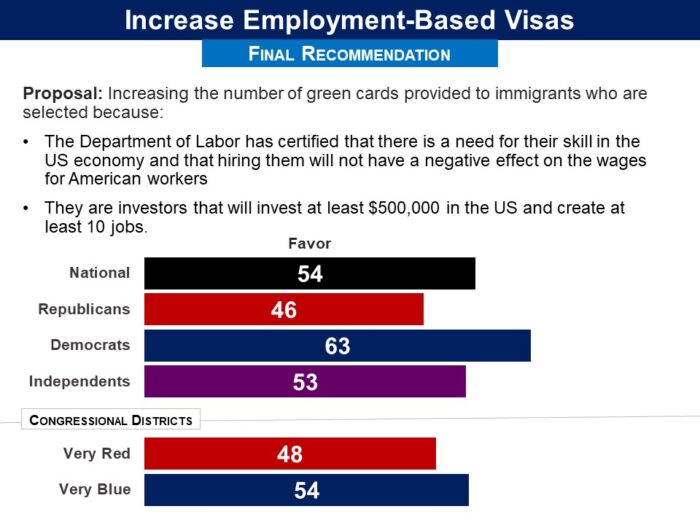
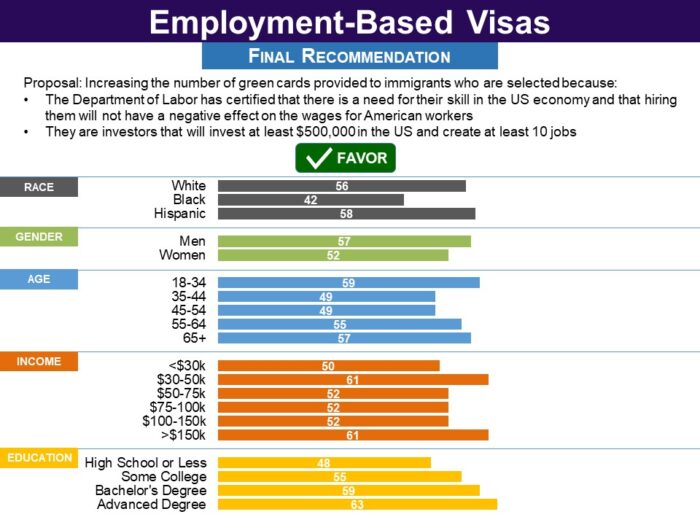 Respondents were also asked to rate the proposals acceptability on a 0-10 scale. It was found at least tolerable (5-10) by 57%, including 53% of Republicans and 63% of Democrats.
Respondents were also asked to rate the proposals acceptability on a 0-10 scale. It was found at least tolerable (5-10) by 57%, including 53% of Republicans and 63% of Democrats.


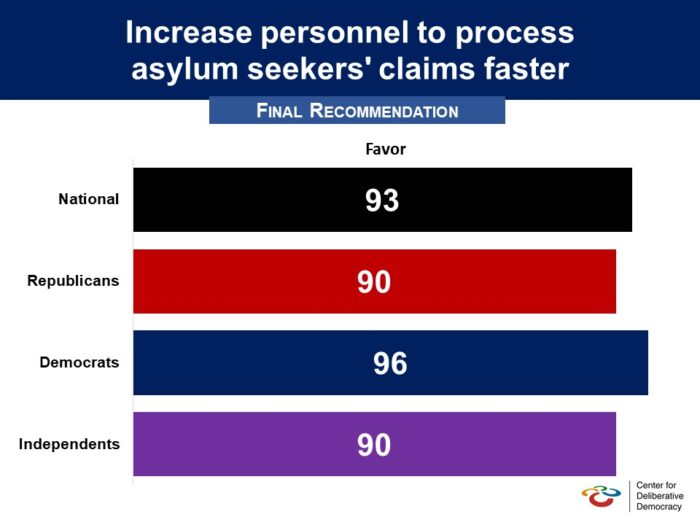 Pre-Deliberation Poll
Pre-Deliberation Poll


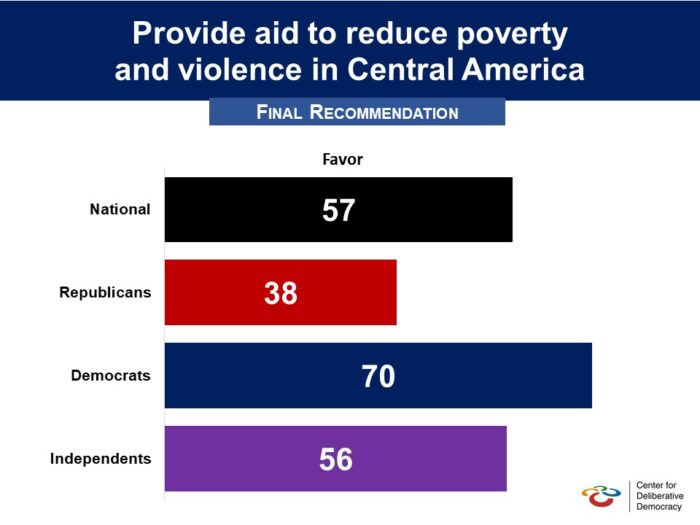 Pre-Deliberation Poll
Pre-Deliberation Poll